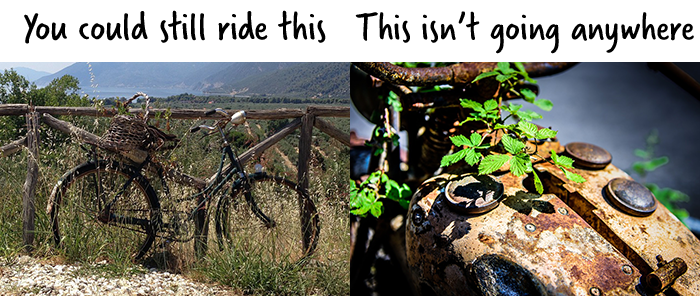About Inspections
Why do I/A systems need to be inspected?
If you think about a conventional septic system as being a bicycle, then you should think about an I/A system as being a motorcycle. A bicycle needs very little maintenance - you replace a tire or a chain now and then, but a bike will go for a long time without even thinking much about maintaining it. A motorcycle, on the other hand, requires regular upkeep to keep it in woking order - the oil has to be changed, fuel and oil filters have to be replaced, and you have to keep gas in it for it to even work at all!

So while a septic tank needs pumping every few years and can last for 20 or more years without much thought, an I/A system, with it's pumps and relays and filters, has to be inspected and maintained regularly to function properly.
What does an I/A inspection typically entail?
Like with a motorcycle, inspecting and maintaining and I/A system involves a number of items, such as:
- gaining access to the system by removing system covers and opening electrical panels;
- inspecting mechanical components, such as pumps, relays, piping and spray nozzles;
- removing and cleaning filters and bacterial growth media;
- inspecting electrical and alarm panels;
- replacing any failed or malfunctioning parts;
Each I/A technology is engineered and built differently, so each comes with it's own inspection "checklist" which has been created by the manufacturer. Your I/A operator will arrive on the site and follow the checklist item-by-item.
IMPORTANT!
System access covers are ugly, so you may be tempted to hide them in your yard. If you bury or conceal any system components, you must make sure they can be easily found and and are accessible by your system operator. He/She may have to remove mulch or other items to conduct your inspection.
It is very important that you give your operator full access to your system. This may include access to an electrical panel which is inside the home. They should also be able to easily locate and access any and all system covers (manhole covers). A hose may also be necessary to clean any filters or other components that may have become fouled. Coordinating with your operator to make sure the whole system is inspected properly is key to ensuring that your system is operating properly.
If your system also has a sampling requirement, your operator will typically take any samples before concluding the inspection. Samples are usually obtained at the system's distribution box. If a water meter reading is required, the operator will also need access to your water meter.
When the operator is done with the inspection, he/she will close the system covers and secure any electrical panels. Many will leave a door tag alerting you to their visit if you are not home.
After returning to the office, you operator will submit the results of the system inspection to this database.
Why am I required to have my system inspected?
Because I/A systems have to be regularly maintained to keep them working properly, both state regulations and your local board of health require that your system be inspected periodically. At the very least, an inspection must be done at least once per year, however MassDEP or your local board of health can require that inspections occur more frequently.
Why not allow people to voluntarily comply? Isn't there an incentive to keep their investment running?
Septic systems by their very nature - receiving and processing human waste products, including feces, urine, skin cells, harmful pathogens, chemicals and other toxic substances - are a public health risk. Because of this, a failed septic system failes to protect public health and safety as well as the environment.
How can I get my inspection requirements reduced?
When an I/A system is newly installed, the owners are usually required to have the system inspected and sampled much more frequently than the minimum. In the vast majority of these instances, inspections and samples are required to occur quarterly. Some municipalities will allow inspections and sampling at a seasonally used property to occur twice during a season. Others may require three visits for a seasonal property, while still others require quarterly inspections and samples regardless of how often the home is occupied.
The purpose of this increased maintenance is to make sure that the system works properly and that it is removing the amount of nutrients (i.e. nitrogen) that is expected.
Most municipalities will allow a system which consistently demonstrates proper operation and nutrient removal performance to obtain reduced requirements. This reduction may change the required inspections and samples from four time s a year to once per year. In some towns, sampling requirements are removed entirely. The result is a substantial yearly cost savings to the homeowner. This cost savings could be in the range of $1,000 or more.
Obtaining a requirements reduction is a relatively straightforward process. Most homeowners will work with their system operator, who will petition the board of health for a requirements reduction. The board will then hold a hearing, during which it's memebers will vote on the legitimacy of the reduction petition. If the board members are satisfied with the performance of the system, they can vote to reduce the requirements.
There are cases in which requirements reductions are a bit more complicated, however. If a system was installed under a "pilot" or "provisional" MassDEP approval (read more about approvals), then the owner must first petition MassDEP to have the requirements reduced, and then also petition their local board of health.
If you have any questions about the requirements reduction process, contact your operator, your local health department, or our office at 508-375-6901 or 508-375-6888.
